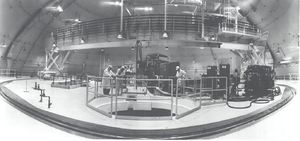Nuclear Power Plants
In many ways, a nuclear power plant is like other power plants. The purpose of all power plants is to produce electricity, and most do so by using a source of heat to create hot steam, which drives a steam engine, which in turn drives an electric generator. Ordinary power plants burn coal or oil to create that heat, but a nuclear plant utilizes the heat from a nuclear reaction. Metals such as uranium are radioactive, which means that their atoms are unstable and tend to break down. When they do, they release energy as heat.
That heat can be captured in a nuclear reactor, an enclosed vessel where many radioactive metal rods are suspended close to each other. Usually some other material is placed in between the rods—it helps to keep the nuclear reaction from getting too hot. Water circulating around the vessel is heated by the reaction to create steam. The steam is carried in pipes to another area of the plant, where it powers special steam engines called steam turbines. These turbines rotate at high speeds, and are connected by a shaft to the electric generator.
Today, about 450 nuclear power plants are in use in about 28 countries around the world, providing about 15-20% of the total electricity supply.
